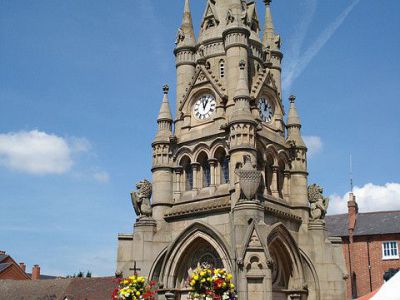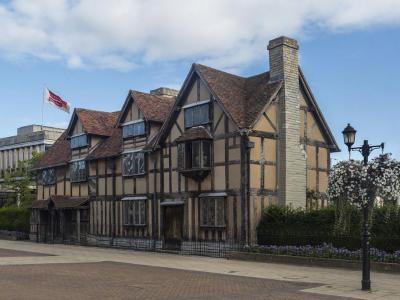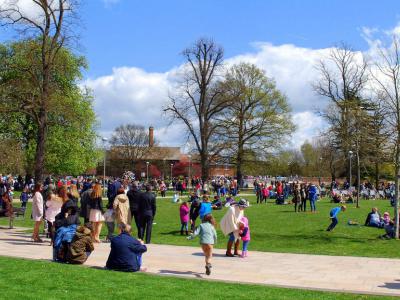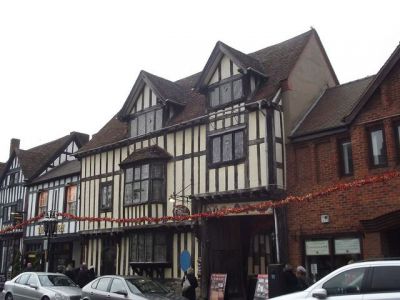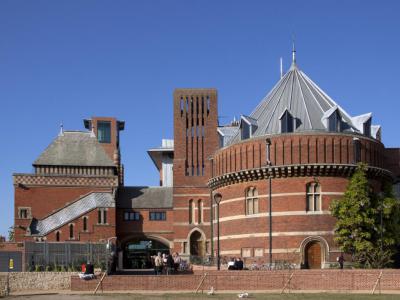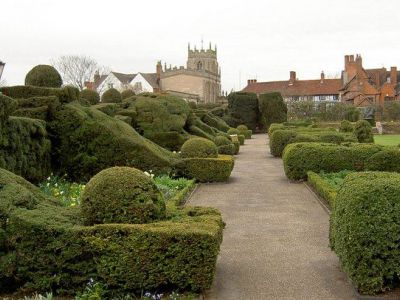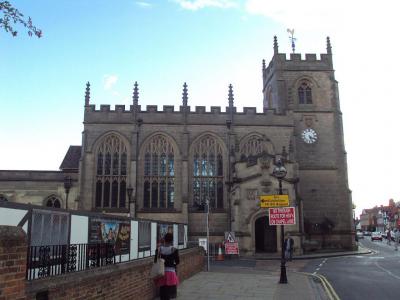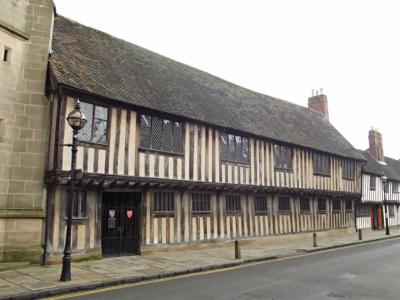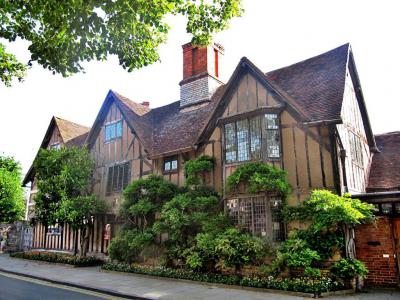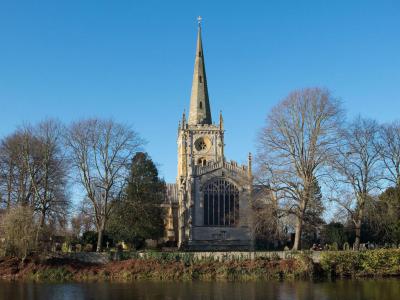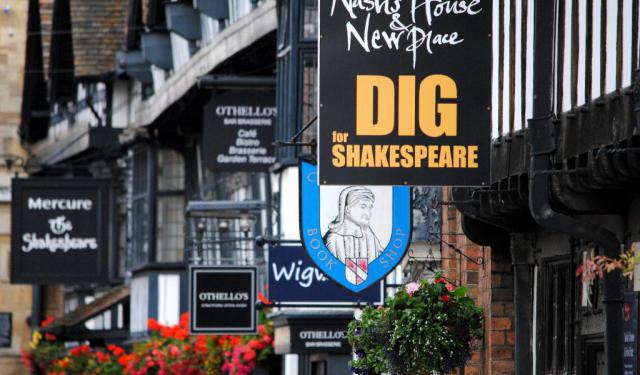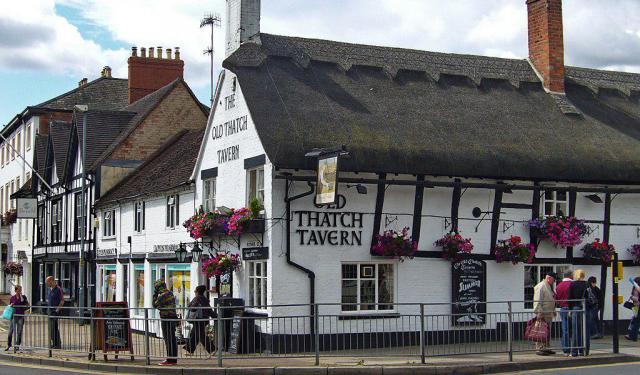
Stratford-upon-Avon Introduction Walking Tour (Self Guided), Stratford-upon-Avon
"Strat" is an Old English term derived from the Latin "Stratum", the word for street. A "ford" is a section of a stream where a crossing may be made. "Avon" is Celtic for river. Put them all together with links like a sausage and you have Stratford-upon-Avon. The ford actually exists. It is now marked by Clopton Bridge.
Primal Stratford was established by Saxon invaders of Warwickshire in the 7th century. In 1196, the lord of the manor, John of Coutances, obtained a charter from Richard I (The Lion-Heart), declaring Stratford-upon-Avon to be a market town. By 1252 the town had shops and a proper Guild, the Guild of the Holy Cross.
The town did not grow much until the Enclosure Acts of the 18th century. Perhaps because of the slow growth, most of the historic buildings have survived until today. They are situated along what is called "Stratford's Historic Spine." The beginning of the spine is marked by William Shakespeare's Birthplace on Henley Street.
From the Birthplace it is an easy walk to High Street, see Elizabethan era houses, like Harvard House. Go to Chapel Street. Find Shakespeare's New Place, where the playwright lived with his family when he returned from London. Walk to Church Street, see the Guild, Hall's Croft and Holy Trinity Church.
There are other things. See the Guild Hall where William studied, the houses of Anne Hathaway, his wife, and Susanna Hall, his daughter, haunted pubs, haunted museums, haunting countryside. But the real haunt, that has drawn thousands of visitors, is the spirit of William Shakespeare. Follow this self-guided walk to touch this great spirit, to feel something of his legacy to art and life.
Primal Stratford was established by Saxon invaders of Warwickshire in the 7th century. In 1196, the lord of the manor, John of Coutances, obtained a charter from Richard I (The Lion-Heart), declaring Stratford-upon-Avon to be a market town. By 1252 the town had shops and a proper Guild, the Guild of the Holy Cross.
The town did not grow much until the Enclosure Acts of the 18th century. Perhaps because of the slow growth, most of the historic buildings have survived until today. They are situated along what is called "Stratford's Historic Spine." The beginning of the spine is marked by William Shakespeare's Birthplace on Henley Street.
From the Birthplace it is an easy walk to High Street, see Elizabethan era houses, like Harvard House. Go to Chapel Street. Find Shakespeare's New Place, where the playwright lived with his family when he returned from London. Walk to Church Street, see the Guild, Hall's Croft and Holy Trinity Church.
There are other things. See the Guild Hall where William studied, the houses of Anne Hathaway, his wife, and Susanna Hall, his daughter, haunted pubs, haunted museums, haunting countryside. But the real haunt, that has drawn thousands of visitors, is the spirit of William Shakespeare. Follow this self-guided walk to touch this great spirit, to feel something of his legacy to art and life.
How it works: Download the app "GPSmyCity: Walks in 1K+ Cities" from Apple App Store or Google Play Store to your mobile phone or tablet. The app turns your mobile device into a personal tour guide and its built-in GPS navigation functions guide you from one tour stop to next. The app works offline, so no data plan is needed when traveling abroad.
Stratford-upon-Avon Introduction Walking Tour Map
Guide Name: Stratford-upon-Avon Introduction Walking Tour
Guide Location: England » Stratford-upon-Avon (See other walking tours in Stratford-upon-Avon)
Guide Type: Self-guided Walking Tour (Sightseeing)
# of Attractions: 10
Tour Duration: 1 Hour(s)
Travel Distance: 1.9 Km or 1.2 Miles
Author: ChristineT
Sight(s) Featured in This Guide:
Guide Location: England » Stratford-upon-Avon (See other walking tours in Stratford-upon-Avon)
Guide Type: Self-guided Walking Tour (Sightseeing)
# of Attractions: 10
Tour Duration: 1 Hour(s)
Travel Distance: 1.9 Km or 1.2 Miles
Author: ChristineT
Sight(s) Featured in This Guide:
- American Fountain
- Shakespeare's Birthplace
- Bancroft Gardens
- Tudor World
- Royal Shakespeare Theatre
- Shakespeare's New Place
- Guild Chapel
- Shakespeare's Schoolroom and Guildhall
- Hall's Croft
- Holy Trinity Church
1) American Fountain
The American Fountain is a beautiful Stratford-Upon-Avon landmark. The Gothic clock tower with a roundabout fountain, was established in 1887 in honor of Queen Victoria's jubilee.
Design is by Jethro Anstice Cossins. Dedication by the actor Henry Irving. The tower is in three stages including arches, recesses, roundels of flowers and fruit carvings. The second stage has a triple arcade, turrets and spiralets. The top has clocks in gables, and figures of Puck, Mustard Seed, Pea-blossom and Cobweb Ltd, fairies-at-law.
It was a gift from George Childs, a Philadelphia newspaper magnate, and that's why it's called the American Fountain. The opening ceremony featured Henry Irving, famous Shakespearean actor. The fountain also features inscriptions and quotations from famous Shakespearian plays.
Design is by Jethro Anstice Cossins. Dedication by the actor Henry Irving. The tower is in three stages including arches, recesses, roundels of flowers and fruit carvings. The second stage has a triple arcade, turrets and spiralets. The top has clocks in gables, and figures of Puck, Mustard Seed, Pea-blossom and Cobweb Ltd, fairies-at-law.
It was a gift from George Childs, a Philadelphia newspaper magnate, and that's why it's called the American Fountain. The opening ceremony featured Henry Irving, famous Shakespearean actor. The fountain also features inscriptions and quotations from famous Shakespearian plays.
2) Shakespeare's Birthplace (must see)
"A Mecca for all lovers of literature." That must be true, judging by all the "lovers of literature" signatures etched into the windows of the house on Henley Street. Years after William Shakespeare left the planet, his admirers came to say hello.
Charles Dickens, Sir Walter Scott, Thomas Carlyle, Lord Byron, Lord Tennyson, John Keats and last but not least, William Thackeray left their names. Here lived the Master of the English Language. What was it like, the house he grew up in? Was it rich, poor, middle class?
It is a very simple house today, but in Shakespeare's time it would have been thought a large dwelling. People were shorter, doors were lower, rooms were smaller. The house was effectively divided in two parts. One was for business and the other for living. Shakespeare's father, John, was a glove maker and a dealer in leather and wool.
It is a restored 16th century half-timbered house in Stratford-upon-Avon, Warwickshire, England. It is a museum now, but in 1564 it was where William Shakespeare was born. The house was constructed of wattle and daub around a timber frame. The fireplaces are of brick and stone and the ground floor is of flagstone.
William Shakespeare inherited the house but by then he had moved with his family to New Place on Chapel Street. Eventually the Henley Street house passed to other owners and by the 1800s it had fallen into a distressed state. In 1846 it was put up for sale. P.T. Barnum of circus fame tried to buy it and ship it "brick by brick" to the USA.
Not having any of that, the Shakespeare Birthplace Committee became the Shakespeare Birthplace Trust by an act of Parliament and stepped in to save the day. The Trust bought the property and restored it to its original state.
Next to the Birthplace is the Shakespeare Centre, a modern building which houses the Shakespeare Birthplace Trust. The Centre contains a library, and a collection of Shakespeare paraphernalia. The Centre also provides admission to the Birthplace.
Why You Should Visit:
William Shakespeare is the heart of this town.
Tips:
Don't worry about driving, parking, etc. There is a tram (good one) and most places to be seen are within walking distance of each other.
Charles Dickens, Sir Walter Scott, Thomas Carlyle, Lord Byron, Lord Tennyson, John Keats and last but not least, William Thackeray left their names. Here lived the Master of the English Language. What was it like, the house he grew up in? Was it rich, poor, middle class?
It is a very simple house today, but in Shakespeare's time it would have been thought a large dwelling. People were shorter, doors were lower, rooms were smaller. The house was effectively divided in two parts. One was for business and the other for living. Shakespeare's father, John, was a glove maker and a dealer in leather and wool.
It is a restored 16th century half-timbered house in Stratford-upon-Avon, Warwickshire, England. It is a museum now, but in 1564 it was where William Shakespeare was born. The house was constructed of wattle and daub around a timber frame. The fireplaces are of brick and stone and the ground floor is of flagstone.
William Shakespeare inherited the house but by then he had moved with his family to New Place on Chapel Street. Eventually the Henley Street house passed to other owners and by the 1800s it had fallen into a distressed state. In 1846 it was put up for sale. P.T. Barnum of circus fame tried to buy it and ship it "brick by brick" to the USA.
Not having any of that, the Shakespeare Birthplace Committee became the Shakespeare Birthplace Trust by an act of Parliament and stepped in to save the day. The Trust bought the property and restored it to its original state.
Next to the Birthplace is the Shakespeare Centre, a modern building which houses the Shakespeare Birthplace Trust. The Centre contains a library, and a collection of Shakespeare paraphernalia. The Centre also provides admission to the Birthplace.
Why You Should Visit:
William Shakespeare is the heart of this town.
Tips:
Don't worry about driving, parking, etc. There is a tram (good one) and most places to be seen are within walking distance of each other.
3) Bancroft Gardens
Bancroft Gardens in Stratford-upon-Avon is a picturesque and historically rich public space situated on the banks of the River Avon, adjacent to the iconic Royal Shakespeare Theatre. This location is a favorite among locals and visitors alike, especially on sunny days when the wide grass lawns and meticulously maintained gardens serve as a serene backdrop against the flowing river.
The Gardens boast a variety of features that celebrate both the local heritage and the universal legacy of William Shakespeare. Notable among these is a unique human sundial that honors the Warwickshire Fire and Rescue Service, highlighting the community's respect for its local heroes. A newly established performance area provides a stage for live events, enhancing the cultural vibrancy of the area.
Central to the Gardens is the magnificent swan fountain and the Gower memorial, which pays tribute to Shakespeare and four of his most memorable characters: Hamlet, Lady Macbeth, Falstaff, and Prince Hal. These figures represent the breadth of Shakespeare's work—philosophy, tragedy, comedy, and history. The memorial, created by Lord Ronald Sutherland Gower and presented to the town in 1888, is a testament to Stratford-upon-Avon's enduring connection to the Bard.
Another highlight is the Country Artists Fountain, sculpted by Christine Lee from stainless steel and brass for the 800th anniversary of the Charter for Market Rights granted by King Richard I in 1196. Unveiled by the Queen in 1996, this fountain adds a modern touch to the Gardens, marrying history with contemporary artistry.
The Bancroft area itself has a long history, initially serving as grazing land for the townspeople's animals. The Canal Basin, which marks the terminus of the Stratford-to-Birmingham canal completed in 1816, and a second canal basin built in 1826 and refilled in 1902, point to the area's industrial past. These elements underscore the transformation of Bancroft Gardens from a functional space into a place of leisure and cultural celebration.
The Gardens boast a variety of features that celebrate both the local heritage and the universal legacy of William Shakespeare. Notable among these is a unique human sundial that honors the Warwickshire Fire and Rescue Service, highlighting the community's respect for its local heroes. A newly established performance area provides a stage for live events, enhancing the cultural vibrancy of the area.
Central to the Gardens is the magnificent swan fountain and the Gower memorial, which pays tribute to Shakespeare and four of his most memorable characters: Hamlet, Lady Macbeth, Falstaff, and Prince Hal. These figures represent the breadth of Shakespeare's work—philosophy, tragedy, comedy, and history. The memorial, created by Lord Ronald Sutherland Gower and presented to the town in 1888, is a testament to Stratford-upon-Avon's enduring connection to the Bard.
Another highlight is the Country Artists Fountain, sculpted by Christine Lee from stainless steel and brass for the 800th anniversary of the Charter for Market Rights granted by King Richard I in 1196. Unveiled by the Queen in 1996, this fountain adds a modern touch to the Gardens, marrying history with contemporary artistry.
The Bancroft area itself has a long history, initially serving as grazing land for the townspeople's animals. The Canal Basin, which marks the terminus of the Stratford-to-Birmingham canal completed in 1816, and a second canal basin built in 1826 and refilled in 1902, point to the area's industrial past. These elements underscore the transformation of Bancroft Gardens from a functional space into a place of leisure and cultural celebration.
4) Tudor World (must see)
Tudor World is a Museum of everyday life in the time of the Tudors. It is located on Sheep Street, Stratford-upon-Avon, almost exactly in the center of town. The museum operates several different tours including the Walking tour with William Shakespeare himself. William answers questions, tells stories and even poses for pictures.
And best of all for some people, is the Ghost tour. The Ghost tour takes place in the evenings, entirely within the confines of the haunted 12th century edifice. It is not recommended for children under 14. It is spooky and that's the best part. It is so spooky William Shakespeare will not take the tour himself (he said so).
Ghostly visions have been reported by some visitors but the management assures us there has never been an attack by a ghost. The management also guarantees there will not be an attack by anyone living. (Anyone LIVING, that is.) The tour relates the history of ghostly visitations in the building and around the town.
Visitors are taken through the Ghost tour by a guide with a lantern. In each room he/she will talk of the ghostly history of the place. The museum is over 400 years old. The rooms have low ceilings and beams and floors slightly warped. This type of thing is not recommended for those who are nervous or who have physical limitations.
For those who are not overly impressed with the Ghost tour, there will be a Halloween "Terror" tour. Be sure to come at Halloween. For the psychic fans there is a Victorian seance. A seance in a haunted house! Will William be there? He does not answer calls. Well, there's always fortune telling. That's even approved for kids.
Tips:
Take the virtual tour first.
And best of all for some people, is the Ghost tour. The Ghost tour takes place in the evenings, entirely within the confines of the haunted 12th century edifice. It is not recommended for children under 14. It is spooky and that's the best part. It is so spooky William Shakespeare will not take the tour himself (he said so).
Ghostly visions have been reported by some visitors but the management assures us there has never been an attack by a ghost. The management also guarantees there will not be an attack by anyone living. (Anyone LIVING, that is.) The tour relates the history of ghostly visitations in the building and around the town.
Visitors are taken through the Ghost tour by a guide with a lantern. In each room he/she will talk of the ghostly history of the place. The museum is over 400 years old. The rooms have low ceilings and beams and floors slightly warped. This type of thing is not recommended for those who are nervous or who have physical limitations.
For those who are not overly impressed with the Ghost tour, there will be a Halloween "Terror" tour. Be sure to come at Halloween. For the psychic fans there is a Victorian seance. A seance in a haunted house! Will William be there? He does not answer calls. Well, there's always fortune telling. That's even approved for kids.
Tips:
Take the virtual tour first.
5) Royal Shakespeare Theatre (must see)
"O for a Muse of fire, that would ascend the brightest heaven of invention...." That comes to mind upon seeing the house and stage of the Royal Shakespeare Theatre (RSC) after its transformation of 2010. The Royal Shakespeare Theatre and the Swan Theatres reopened in 2010 after the extensive changes wrought by the Transformation Project.
This was a redo of the Shakespeare Memorial Theatre (SMT) which had been opened in 1932. The original theatre had been destroyed by fire six years earlier. The new SMT was designed by Elisabeth Scott. Ms Scott's theatre was renamed to Royal Shakespeare Theatre in 1961 after the creation of the Royal Shakespeare Company the previous year.
The RST is a 1,040 seat theatre with a thrust stage, bounded by the audience on three sides. The theatre is owned by the Royal Shakespeare Company (RSC). The new theatre is referred to as a "one room" theatre. Actors and audience are close together in the same room, as in Shakespeare's time. The play is an intimate experience for all.
The Theatre has a Rooftop Restaurant and bar offering views of the river Avon. There are also a Riverside Cafe and Terrace. There is a colonnade linking the RSC and the Swan Theatre. There is a tower, 118 feet in height with dramatic perspectives of the town and countryside. A riverside walk reaches from Bancroft Gardens past the Theatre.
Queen Elizabeth II and Prince Philip officially opened the Theatre in March 2011. An urn with the ashes of Actor Ian Richardson was placed in the foundation by his widow and son in 2007.
This was a redo of the Shakespeare Memorial Theatre (SMT) which had been opened in 1932. The original theatre had been destroyed by fire six years earlier. The new SMT was designed by Elisabeth Scott. Ms Scott's theatre was renamed to Royal Shakespeare Theatre in 1961 after the creation of the Royal Shakespeare Company the previous year.
The RST is a 1,040 seat theatre with a thrust stage, bounded by the audience on three sides. The theatre is owned by the Royal Shakespeare Company (RSC). The new theatre is referred to as a "one room" theatre. Actors and audience are close together in the same room, as in Shakespeare's time. The play is an intimate experience for all.
The Theatre has a Rooftop Restaurant and bar offering views of the river Avon. There are also a Riverside Cafe and Terrace. There is a colonnade linking the RSC and the Swan Theatre. There is a tower, 118 feet in height with dramatic perspectives of the town and countryside. A riverside walk reaches from Bancroft Gardens past the Theatre.
Queen Elizabeth II and Prince Philip officially opened the Theatre in March 2011. An urn with the ashes of Actor Ian Richardson was placed in the foundation by his widow and son in 2007.
6) Shakespeare's New Place (must see)
In 1597 William Shakespeare was founder of the Lord Chamberlain's Men and a successful playwright. He had left his Birthplace House. He had moved to his newer, larger house, which he had bought for 129 pounds. The New Place (for so it was called) was located on Chapel Street, but a short walk from the Birthplace House on Henley Street.
New Place had been built in the 15th century by Hugh Clopton. The terms "New" or "Newer" as used in Britain are relative and not to be taken literally. One might say, "newer than the pyramids", for example. The New Place had a five gabled, three bayed, half-timbered frontage. Shakespeare rebuilt the frontage and added a gallery.
New Place was pulled down in the late 17th century by the Clopton family who had reacquired the property. The Clopton's newer New Place itself was demolished in 1759. Now New Place is occupied by a garden designed to memorialize Shakespeare's life and work and to allow visitors to develop their own connections with his legacy.
The Great Garden is behind the site where the house once stood. The garden shows sculptures based on Shakespeare's writings. The Knot Garden has been restored using designs which would have been familiar to Shakespeare himself.
New Place had been built in the 15th century by Hugh Clopton. The terms "New" or "Newer" as used in Britain are relative and not to be taken literally. One might say, "newer than the pyramids", for example. The New Place had a five gabled, three bayed, half-timbered frontage. Shakespeare rebuilt the frontage and added a gallery.
New Place was pulled down in the late 17th century by the Clopton family who had reacquired the property. The Clopton's newer New Place itself was demolished in 1759. Now New Place is occupied by a garden designed to memorialize Shakespeare's life and work and to allow visitors to develop their own connections with his legacy.
The Great Garden is behind the site where the house once stood. The garden shows sculptures based on Shakespeare's writings. The Knot Garden has been restored using designs which would have been familiar to Shakespeare himself.
7) Guild Chapel
"defasyng images in ye chapel". For defacing paintings on the Guild Chapel walls, John Shakespeare, Willam Shakespeare's father, was paid two shillings. Its not a lot, considering the time he put in. Elizabeth I was in office, and she issued an injunction in 1559 to "remove all signs of superstition and idolatry from places of worship."
The Guild Chapel was founded by the Guild of the Holy Cross in 1269. The Chapel stands today on Church Street, across from William Shakespeare's New Place. Hugh Clopton, a former owner of New Place, had presented murals to the Chapel. It is ironic that John Shakespeare made money whitewashing the murals that were funded by Clopton.
The Guild was suppressed during the Reformation. Its property was turned over to the Corporation of Stratford. The murals were uncovered in the 1950s. A major restoration is in progress to restore the mural of Doom over the chancel arch together with the Death Poem. Seen from the outside the Chapel is a plain building with a high tower.
Restored in 1983 by Stephen Dykes Bower, The Chapel has a Grade I listing. It is owned and operated by The Stratford-upon-Avon Town Trust. The Chapel is in use as a chapel, providing services for King Edward VI School.
The Guild Chapel was founded by the Guild of the Holy Cross in 1269. The Chapel stands today on Church Street, across from William Shakespeare's New Place. Hugh Clopton, a former owner of New Place, had presented murals to the Chapel. It is ironic that John Shakespeare made money whitewashing the murals that were funded by Clopton.
The Guild was suppressed during the Reformation. Its property was turned over to the Corporation of Stratford. The murals were uncovered in the 1950s. A major restoration is in progress to restore the mural of Doom over the chancel arch together with the Death Poem. Seen from the outside the Chapel is a plain building with a high tower.
Restored in 1983 by Stephen Dykes Bower, The Chapel has a Grade I listing. It is owned and operated by The Stratford-upon-Avon Town Trust. The Chapel is in use as a chapel, providing services for King Edward VI School.
8) Shakespeare's Schoolroom and Guildhall (must see)
Here is an interactive peek into William Shakespeare's childhood and schooling in the 16th century. The Guild of the Holy Cross built the Guildhall in 1420. Over the years more buildings were added, including a schoolhouse, a Chapel and Almshouses. The Guildhall was the headquarter of the Stratford Borough Council from 1553 and 1848.
When the Borough Council left for new digs at the Town Hall, they left the building to the school. The school, known as The King's New school, had been in the Guildhall since 1568. It later became the King Edward VI School (K.E.S.). Three years later seven-year-old William Shakespeare attended his first class. One may assume it was writing.
The school has been in continuous use by the local people since it first opened. The Guildhall has always been used and looked after and never neglected. Not only local students may study here, the school is also open to tourists. They may take an interactive class with William Shakespeare's teacher, Master Thomas Jenkins.
Adjoining the Guildhall is the Armoury. It was originally used a store place for arms, but after 1553 it became an administration center for the school. It also served as courtroom. On the first floor is the Master's chamber. In the center of the chamber is the prefect's table, bearing the names and initials of schoolboys through the years.
Students were mostly the children of wealthy middle class people. Williams' father, for instance, was the bailiff for the town. It was a public school and an entrance exam was required. Students did not pay fees, but they did have to provide their own firewood and candles. Classes frequently went from 6 am to 6 pm. There was a brief midday break.
Why You Should Visit:
to experience a bit how education used to be.
Tips:
When using the feather quill, be wary of ink blots.
When the Borough Council left for new digs at the Town Hall, they left the building to the school. The school, known as The King's New school, had been in the Guildhall since 1568. It later became the King Edward VI School (K.E.S.). Three years later seven-year-old William Shakespeare attended his first class. One may assume it was writing.
The school has been in continuous use by the local people since it first opened. The Guildhall has always been used and looked after and never neglected. Not only local students may study here, the school is also open to tourists. They may take an interactive class with William Shakespeare's teacher, Master Thomas Jenkins.
Adjoining the Guildhall is the Armoury. It was originally used a store place for arms, but after 1553 it became an administration center for the school. It also served as courtroom. On the first floor is the Master's chamber. In the center of the chamber is the prefect's table, bearing the names and initials of schoolboys through the years.
Students were mostly the children of wealthy middle class people. Williams' father, for instance, was the bailiff for the town. It was a public school and an entrance exam was required. Students did not pay fees, but they did have to provide their own firewood and candles. Classes frequently went from 6 am to 6 pm. There was a brief midday break.
Why You Should Visit:
to experience a bit how education used to be.
Tips:
When using the feather quill, be wary of ink blots.
9) Hall's Croft (must see)
Nearby to New Place was the house that William Shakespeare never lived in. Hall's Croft was the home of Susanna Shakespeare, William Shakespeare's daughter, and her husband, Doctor John Hall. Like New Place, Susanna's house had a flagstone floor. A stone floor was a sign of status. Most houses had earthen floors. The Halls were wealthy and they didn't mind showing it.
They owned fine furniture, heavy and strong, hand made from oak and very expensive. When Patients and other visitors entered the house, they understood the homeowner was someone to be respected. An enormous amount of work has been done on the house. The furniture appears authentic. But none of the original furniture remains.
The home contains a fine collection of 16th and 17th paintings. Doctor Hall is represented by his medical paraphernalia. Interesting to compare Jacobean medical practices to modern science. In the back of the house is a walled garden. The garden is maintained and it holds herbs and plants Doctor Hall might have used in his practice.
They owned fine furniture, heavy and strong, hand made from oak and very expensive. When Patients and other visitors entered the house, they understood the homeowner was someone to be respected. An enormous amount of work has been done on the house. The furniture appears authentic. But none of the original furniture remains.
The home contains a fine collection of 16th and 17th paintings. Doctor Hall is represented by his medical paraphernalia. Interesting to compare Jacobean medical practices to modern science. In the back of the house is a walled garden. The garden is maintained and it holds herbs and plants Doctor Hall might have used in his practice.
10) Holy Trinity Church (must see)
It is clear that Willam Shakespeare loved Stratford-upon-Avon. He was born in a house on Henley Street. The house was not far from Holy Trinity Church, where he was baptized, married and finally buried. He wanted to be always in the place where he arrived. He even has a plaque next to his burial place cursing anyone who would dare disturb his rest.
"...and cursed be he that moves my bones." To date, no one ever has. Many, many people have visited the Church, and looked at his effigy and read his plaque and wondered.
The Church dates from 1210. It stands on the site of an old Saxon monastery. It is, in fact, Stratford-upon-Avon's oldest building. John de Stratford founded a chantry here sometime in the 14th century. Dean Thomas Balshall rebuilt the chantry in 1491. Balshall is buried in the Church.
Within the church are several interesting items. There are: A 14th century porch knocker; more than twenty carved misericord seats in the chancel; The American window in Saint Peter's Chapel, donated by George Williams Childs, "The Gift of America to Shakespeare's Church"; and copies of Shakespeare's baptismal and burial certificates.
"...and cursed be he that moves my bones." To date, no one ever has. Many, many people have visited the Church, and looked at his effigy and read his plaque and wondered.
The Church dates from 1210. It stands on the site of an old Saxon monastery. It is, in fact, Stratford-upon-Avon's oldest building. John de Stratford founded a chantry here sometime in the 14th century. Dean Thomas Balshall rebuilt the chantry in 1491. Balshall is buried in the Church.
Within the church are several interesting items. There are: A 14th century porch knocker; more than twenty carved misericord seats in the chancel; The American window in Saint Peter's Chapel, donated by George Williams Childs, "The Gift of America to Shakespeare's Church"; and copies of Shakespeare's baptismal and burial certificates.
Walking Tours in Stratford-upon-Avon, England
Create Your Own Walk in Stratford-upon-Avon
Creating your own self-guided walk in Stratford-upon-Avon is easy and fun. Choose the city attractions that you want to see and a walk route map will be created just for you. You can even set your hotel as the start point of the walk.
William Shakespeare Walking Tour
The picturesque town of Stratford-upon-Avon is steeped in the history of William Shakespeare. Indeed, Shakespeare's hometown is where he was born and also where he passed away on the same day (23 April) 52 years later.
Many period locations in town, related to his and his family's life, are preserved as Britain's national heritage and visited by millions of people every year in a... view more
Tour Duration: 1 Hour(s)
Travel Distance: 1.4 Km or 0.9 Miles
Many period locations in town, related to his and his family's life, are preserved as Britain's national heritage and visited by millions of people every year in a... view more
Tour Duration: 1 Hour(s)
Travel Distance: 1.4 Km or 0.9 Miles
Historical Tudor Houses Walking Tour
The first thing that strikes one walking across the medieval center of Stratford-Upon-Avon is the abundance of timber-framed Tudor houses. Their most notable feature, often combined with an overhanging upper story, is an exposed wooden framework; the rest is typically filled with brick, plaster or wattle-and-daub.
Many of these buildings have been kept in their original state, notably the... view more
Tour Duration: 1 Hour(s)
Travel Distance: 1.1 Km or 0.7 Miles
Many of these buildings have been kept in their original state, notably the... view more
Tour Duration: 1 Hour(s)
Travel Distance: 1.1 Km or 0.7 Miles
The Most Popular Cities
/ view all
